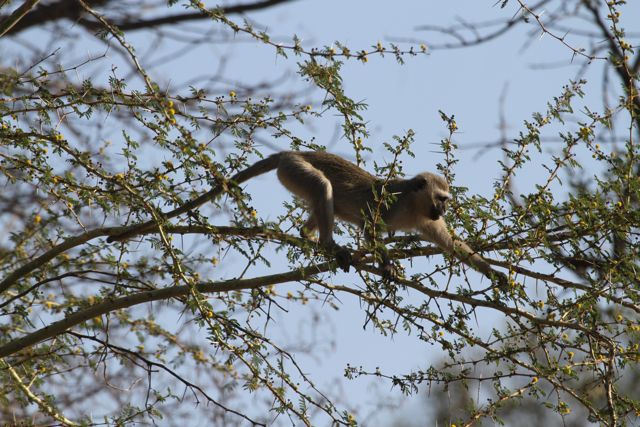I have been on a tree rave for the past few days. Admittedly the wild dogs have chased all the animals off the floodplains, and the cold biting wind has kept the elephants away, so the trees have a chance to stand in the center stage.
Bright sunlight and cold blue shadows dazzle at midday and play on the bark of sculpted leadwood trees, and broad acacias. The last baobab in this area was finally eaten by elephants last year. RIP brother tree.
This morning we were out at sunrise, a warm orange glow above the tree line reflected in the floodwaters. I felt sure we would find the leopard and braved the biting wind to stand and scour the trees and grasses on either side of the track. To no avail though - not this time. Tracks of wild dogs, hyenas and jackals make patterns on the road. The fine sand perfectly showing every crack and claw - telling us the details of the nightly procession. Here and there elephants have crossed the road, their giant oval wrinkly footprints flattening out the sand. Baby elephant prints look tiny by comparison but are probably the size of a human handprint, which in lion spoor terms would be very big.
aardvark tracks in wet sand
We head into the back country, through waving yellow grasses and onto the rise where a massive sausage tree presides over a ridge of extraordinary trees. The base of the sausage tree is ringed with elephant tracks, yet the trunk remains undamaged. Just a jump away is a spreading camel thorn acacia which has been completely ring barked by elephants and will never see another growing season. I stoop to pick up one of the acacia pods - acacia erioloba - it looks like a smooth grey velvety ear and rattles with ripe seeds inside. This could be the last chance this tree has to sow its seed.
I have to hug the sausage tree. On the side in the sun the bark is faintly warm. I am not generally prone to hugging trees but somehow this one looked so big and round and strong, bedecked in a canopy of rich green leaves and loved by elephants. It felt commanding, matriarchal, patriarchal, whatever - I just had to show my appreciation.
how to listen to a tree
With my arms spread, I could only just reach nearly half way around. My face pressed against the warm bark, I felt the strength of this tree - the energy running up from earth to sky. I listened, pressing my ear to the trunk, the way i had seen that elephant do to the leadwood tree. And yes, I could hear something, I am sure i did. The tree spoke to me.
In my Field Guide to Trees of the Okavango Delta by Veronica Roodt, it says
"The Sausage Tree is deemed holy by many tribes and religious gatherings are often held in its shade. It is said that hanging one of these fruits in one's hut will protect one from whirlwinds"
the moon in the sausage tree
The green leaves shine against a deep blue winter sky. And there between the branches is a half moon smiling back at me in a lopsided way. Meyers parrots swoop past calling excitedly.
We take leave of my new friend, the tree, and follow an elephant path winding through the back country which leads us to a series of small muddy pans, some dry now, and some still with a small base of water. The elephants love this path too although there are none to be seen this morning, they were here last night for sure. Ghost elephants.
the three sisters
We link up with the familiar path close to the three leadwood trees I now call the Three Sisters. They stand together but each have entirely individual characters. They are probably about the same age, although the middle one is slightly stouter. She had a swarm of bees in her bonnet last month when the bees were swarming. Her whole being vibrated with a low hum from their activity. In my same book it says that" Hereros and Ovambos of Namibia regard the leadwood tree as the great ancestor of all animals and people and they never pass it without paying it the necessary respect".
Around and in the wide view, trees shaped by seasons of elephants and sun, wind and rain, stand in pools of yellow grass like strategically placed sculptures. They cannot move but we can - yet we return again and again to the wisdom of the trees and I shall be back to hug my friend.










